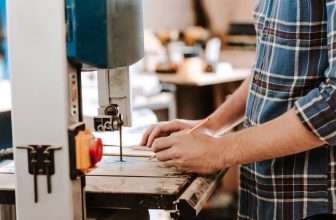Contents
Tales of missing fingers and trips to the emergency room are common in the woodworking world although these are things you can easily avoid if you keep safety in mind. Any machine with a blade running at high speeds is going to be somewhat dangerous, but our guide to bandsaw safety will help you tame your new tool in no time.
Common Sense goes a long way…
Even if you never took a class in wood shop during high school, common sense can go a long way when it comes to dealing with woodworking equipment.
Sawdust can blind you in an instant, and that is not ideal whether you are resawing stock or cutting a curved pattern. That’s where a good pair of safety glasses will save the day, and a good dust or chip collection system can ensure stray debris is kept to a minimum.
Another obvious but overlooked area to keep in mind is the power switch. You should never leave your saw running unattended or when not in use. That’s an accident waiting to happen, and simply flipping a switch can save you from a potential disaster.
While ear protection and gloves are a personal preference for many woodworkers, they are something to keep in mind as well. Long, loose sleeves are one item that’s even up for debate, however, as you do not want anything hanging that could become snagged by a saw blade or wheel.
Bandsaw Safety Features
On the chance that something happens to go wrong while your bandsaw is in use, there are several safety features built into machines on the market today. We’re going to briefly discuss the main three you are likely to encounter with the Wheel Covers, Blade Guard and Blade Tensioning system.
Wheel Covers
As the name implies, Wheel Covers hide the wheels inside of the saw’s frame. These wheels turn at a high rate of speed, so you always want to make sure these covers stay shut when the saw is in use. You will have to remove or open them to change your blade, but that’s a small price to pay for safety.
Blade Guard
Blade Guards live up to their namesake by guarding your fingers against the spinning bandsaw blade. Always keep any guards in place to prevent accidental kickbacks or slippage. While you should always handle your stock properly, even expert artisans have had their hands slip on the bandsaw table.
Blade Tension
Keep an eye on your blade tension at all times. Whether you’re switching to a harder wood or the saw has been idle for a few weeks, you need to ensure the blade is taught, but not too tight. Overtightening your blade can cause it to break while a loose bandsaw blade can slip right off the wheels. Always check your tension before using the saw and make sure it’s tracking properly.
How to use a Bandsaw Safely
One of the most important things to keep in mind with bandsaw safety is to look over the machine before each use. We cannot stress that point enough, and it’s not just about testing the tension or checking the travel.
Check your machine before every use
Any piece of equipment will wear down over time; no matter how well maintained it is. General maintenance certainly helps, but you still need to check the machine itself. That includes the frame and wheels along with any moving parts that could experience wear and tear.
Even the strongest frames or parts can crack, so it’s also important to “listen” to your machine. Once you become accustomed to how it runs, you will quickly notice a change and should shut it down if something seems off.
One of the worst things you can hear would be a click. If you hear this dreaded sound, turn off the machine and step away until it stops spinning. Clicking can mean other things, but it usually means your blade is cracked and could possibly snap within seconds.
Handling the Stock
It’s important to be cautious when handling wood as well. We’re not just talking about getting a splinter under a fingernail either although that is one thing that can quickly ruin your day.
When handling stock, you always want to make sure you have placed it flat on the table. If you need an angled cut, adjust the table, not the wood. You should pull any longer boards out from the back of the saw and when pushing stock into the blade always keep your hands to the side.
A fence is a popular and safe option for woodworkers of all skill levels as well. It acts as a guide that attaches to your table and gives you an edge to work against. This keeps your hands in the proper position and is ideal for rips and long cuts where precision is key.
Relief Cuts
Curvy cuts can be difficult for beginners to master and it’s something that can bind up a bandsaw in an instant. While you need to go slow and have your saw set to the proper speed, there is one trick that can help you get through tough curves.
Instead of backing your saw out of a curved cut, you can make a series of relief cuts. These are made through the “scrap” part of the stock and provide you with more room to work. Alternatively, nibble cutting is another option that works in a similar fashion by allowing to you work with the excess material.
Conclusion
While using a bandsaw for the first time can be frightening, there’s no need to be fearful of your new equipment. Simply keeping your saw and your shop clean from debris and keeping your hands out of the way are two of the easiest ways to keep things safe along with our quick tips regarding loose-fitting clothing and tension.
Again, we want to stress the importance of wearing safety glasses around your machine. It’s one area people tend to skip when they get in a rush, but you never want to operate your saw without proper eye protection.






